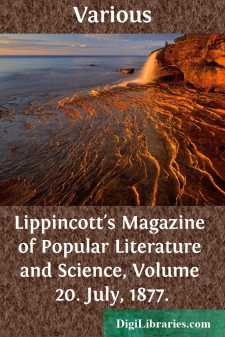Categories
- Antiques & Collectibles 13
- Architecture 36
- Art 48
- Bibles 22
- Biography & Autobiography 813
- Body, Mind & Spirit 142
- Business & Economics 28
- Children's Books 17
- Children's Fiction 14
- Computers 4
- Cooking 94
- Crafts & Hobbies 4
- Drama 346
- Education 46
- Family & Relationships 57
- Fiction 11829
- Games 19
- Gardening 17
- Health & Fitness 34
- History 1377
- House & Home 1
- Humor 147
- Juvenile Fiction 1873
- Juvenile Nonfiction 202
- Language Arts & Disciplines 88
- Law 16
- Literary Collections 686
- Literary Criticism 179
- Mathematics 13
- Medical 41
- Music 40
- Nature 179
- Non-Classifiable 1768
- Performing Arts 7
- Periodicals 1453
- Philosophy 64
- Photography 2
- Poetry 896
- Political Science 203
- Psychology 42
- Reference 154
- Religion 513
- Science 126
- Self-Help 84
- Social Science 81
- Sports & Recreation 34
- Study Aids 3
- Technology & Engineering 59
- Transportation 23
- Travel 463
- True Crime 29
Lippincott's Magazine of Popular Literature and Science, Volume 20. July, 1877.
by: Various
Description:
Excerpt
Wiesbaden (the "Meadow-Bath"), though an inland town, partakes of some of the Rhine characteristics, though even if it did not, its notoriety as a spa would be enough to make some mention of it necessary. Its promenade and Kurhaus, its society, evening concerts, alleys of beautiful plane trees, its frequent illuminations with Bengal lights, reddening the classic peristyles and fountains with which modern taste has decked the town, its airy Moorish pavilion over the springs, and its beautiful Greek chapel with fire-gilt domes, each surmounted by a double cross connected with the dome by gilt chains—a chapel built by the duke Adolph of Nassau in memory of his wife, Elizabeth Michaelovna, a Russian princess,—are things that almost every American traveler remembers, not to mention the Neroberger wine grown in the neighborhood.
Schlangenbad, a less well-known bathing-place, is a favorite goal of Wiesbaden excursionists, for a path through dense beech woods leads from the stirring town to the quieter "woman's republic," where, before sovereigns in incognito came to patronize it, there had long been a monopoly of its charms by the wives and daughters of rich men, bankers, councilors, noblemen, etc., and also by a set of the higher clergy. The waters were famous for their sedative qualities, building up the nervous system, and, it is said, also beautifying the skin. Some credulous persons traced the name of the "Serpents' Bath" to the fact that snakes lurked in the springs and gave the waters their healing powers; but as the neighborhood abounds in a small harmless kind of reptile, this is the more obvious reason for the name. I spent a pleasant ten days at Schlangenbad twelve or thirteen years ago, when many of the German sovereigns preferred it for its quiet to the larger and noisier resorts, and remember with special pleasure meeting with fields of Scotch heather encircled by beech and chestnut woods, with ferny, rocky nooks such as—when it is in Germany that you find them—suggest fairies, and with a curious village church, just restored by a rich English Catholic, since dead, who lived in Brussels and devoted his fortune to religious purposes all over the world. This church was chiefly interesting as a specimen of what country churches were in the Middle Ages, having been restored in the style common to those days. It was entirely of stone, within as well as without, and I remember no painting on the walls. The "tabernacle," instead of being placed on the altar, as is the custom in most churches now, and has been for two or three hundred years, was, according to the old German custom, a separate shrine, with a little tapering carved spire, placed in the corner of the choir, with a red lamp burning before it. Here, as in most of the Rhine neighborhoods, the people are mainly Catholics, but in places where summer guests of all nations and religions are gathered there is often a friendly arrangement by which the same building is used for the services of two or three faiths. There was, I think, one such at Schlangenbad, where Catholic, Lutheran and Anglican services were successively held every Sunday morning; and in another place, where a large Catholic church has since been built, the old church was divided down the middle of the nave by a wooden partition about the height of a man's head, and Catholic and Protestant had each a side permanently assigned to them for their services. This kind of practical toleration, probably in the beginning the result of poverty on both sides, but at any rate creditable to its practicers, was hardly to be found anywhere outside of Germany. I remember hearing of the sisters of one of the pope's German prelates, Monsignor Prince Hohenlohe, who were Lutherans, embroidering ecclesiastical vestments and altar-linen for their brother with as much delight as if he and they believed alike; and (though this is anything but praiseworthy, for it was prompted by policy and not by toleration) it was a custom of the smaller German princes to bring their daughters up in the vaguest belief in vital truths, in order that when they married they might become whatever their husbands happened to be, whether Lutheran, Anglican, Catholic or Greek....












